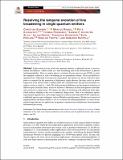Resolving the temporal evolution of line broadening in single quantum emitters
Abstract
Light emission from solid-state quantum emitters is inherently prone to environmental decoherence, which results in a line broadening and in the deterioration of photon indistinguishability. Here we employ photon correlation Fourier spectroscopy (PCFS) to study the temporal evolution of such a broadening in two prominent systems: GaAs and In(Ga)As quantum dots. Differently from previous experiments, the emitters are driven with short laser pulses as required for the generation of high-purity single photons, the time scales we probe range from a few nanoseconds to milliseconds and, simultaneously, the spectral resolution we achieve can be as small as ∼ 2µeV. We find pronounced differences in the temporal evolution of different optical transition lines, which we attribute to differences in their homogeneous linewidth and sensitivity to charge noise. We analyze the effect of irradiation with additional white light, which reduces blinking at the cost of enhanced charge noise. Due to its robustness against experimental imperfections and its high temporal resolution and bandwidth, PCFS outperforms established spectroscopy techniques, such as Michelson interferometry. We discuss its practical implementation and the possibility to use it to estimate the indistinguishability of consecutively emitted single photons for applications in quantum communication and photonic-based quantum information processing.
Citation
Schimpf , C , Reindl , M , Klenovský , P , Fromherz , T , Covre Da Silva , S F , Hofer , J , Schneider , C , Höfling , S , Trotta , R & Rastelli , A 2019 , ' Resolving the temporal evolution of line broadening in single quantum emitters ' , Optics Express , vol. 27 , no. 24 , pp. 35290-35307 . https://doi.org/10.1364/OE.27.035290
Publication
Optics Express
Status
Peer reviewed
ISSN
1094-4087Type
Journal article
Description
Funding: H2020 European Research Council (679183); Austrian Science Fund (P29603); Seventh Framework Programme (601126); Central European Institute of Technology (7AMB17AT044); Horizon 2020 Framework Programme (731473); European Metrology Programme for Innovation and Research (17FUN06); Bundesministerium für Wissenschaft, Forschung und Wirtschaft (CZ 07 / 2017); Ministerstvo Školství, Mládeže a Telovýchovy; QuantERA (Hyper-U-P-S); QuantERA (CUSPIDOR); Linz Institute of Technology (LIT); LIT Secure and Correct Systems Lab; Bayerisches Staatsministerium für Bildung und Kultus, Wissenschaft und Kunst; Deutsche Forschungsgemeinschaft (SCHN1376 5.1).Collections
Items in the St Andrews Research Repository are protected by copyright, with all rights reserved, unless otherwise indicated.

